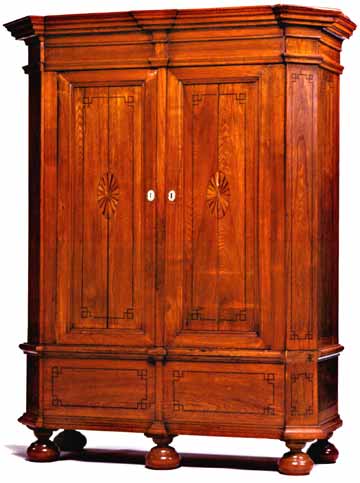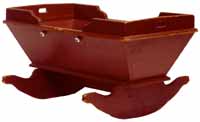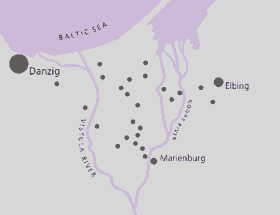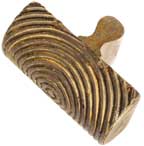 |
|||||||||
| deu | rus | pol | |||||||
The Story of
|
|||||||||
What is Mennonite Immigrant Furniture?Key Furniture TypesSources for the Vistula Delta TraditionMaking the Tradition MennoniteMigration of the TraditionMigration to the New WorldThe Waning of the TraditionPreserving the Tradition
|
 Classen family wardrobe, ca. 1820 |

Cradle made by Jacob Kauffman, ca. 1880 |
What is Mennonite immigrant furniture?In the 1870s and 1880s Mennonites emigrated from Prussia, Poland and south Russia to the Plains of North America. The only furniture that many could bring was a dowry chest, which served as a travel trunk. Among the immigrants were skilled cabinetmakers and carpenters who built furniture for their new homes on the Plains. The new furniture was made and decorated in the style of furniture they left behind in Europe. Generally Mennonite immigrant furniture was large, sturdy and constructed of ash or pine. The furniture was decorated with inlaid veneer, paint or stain. |
|
|
Key Furniture TypesMennonite immigrant furniture has distinct forms, functions and style. With roots in Poland’s Vistula Delta, this cultural-historical tradition is different from Pennsylvania German Mennonite and Amish furniture which originated in Switzerland and south Germany. Mennonite immigrant furniture pieces are known by their Low German (Plautdietsch) names: dowry chest K jistcorner cabinet Akjschaup pull-out bed Bad, Loaga, Bocht cradle Waej sleeping bench Schlopbenkj resting bench Ruebenkj wardrobe Kjleedaschaup wall cabinet Miaschaup glass cabinet Glasschaup table Desch Some furniture items were commonly found in the north European homes of Mennonites and non-Mennonites alike: utility cupboard (Schaup), chair (Stool), utility bench (Benkj), clock (Klock). The cabinetry joints used in Mennonite furniture are butterfly key, dovetail, mortise and tenon, tongue and groove, and wood pin. A less well known joinery technique is the wedge cleat, often used to connect the bottom and top cases of a wardrobe to the central portion. |
 |
Sources for the Vistula Delta TraditionThe furniture tradition that immigrant Mennonites brought to the Plains had its origins in the delta of the Vistula River of northern Poland. • folk customThe Kashubians were early inhabitants of the Vistula Delta. These Slavic peasants painted their hand-built wood furniture, which included dowry chests and cradles. • guild traditionDanzig (today Gdansk) and Elbing (Elblag) were trading centers whose craftsmen organized into guilds to make goods for the Polish upper class. Guild cabinetmakers built fine inlaid dowry chests and wardrobes. • Biedermeier fashionIn the early nineteenth century, the emerging middle-class in German-speaking regions favored furniture known as Biedermeier. The neo-classical forms and ornaments resembled French Empire and English Regency styles. |
Making the Tradition MennoniteIn the sixteenth century, Mennonites fleeing religious persecution in the Netherlands found refuge in the delta region of the Vistula River. The Mennonites learned the Low German dialect of the Vistula Delta and then High German when the region became part of Prussia in 1772. As Mennonites in the Vistula Delta built churches and houses, they preserved many Dutch traditions. But they were also influenced by Vistula Delta building methods and use of space as well as furniture forms and ornamentation. As Mennonites adopted the architecture and furniture of their neighbors, the elements of the Vistula Delta tradition became Mennonite. |
|
 |
Migration of the TraditionWhen the Vistula Delta was taken over by Prussia in 1772, Emperor Frederick the Great imposed heavy taxes and canceled special privileges such as leasing blocks of land and exemption from military service. Some Mennonites began searching for opportunities for a better life. Nobles in central Poland and Russia sought industrious farmers to clear forests and develop the land for farming. Promises of land and religious tolerance attracted Mennonites from the Vistula Delta as well as Mennonites with origins in Switzerland. Empress Catherine the Great of Russia invited Mennonites to colonize the newly conquered area along the Dnieper River. From 1789 to 1802, some 460 Mennonite families of the Vistula Delta moved to Chortitza in south Russia (now Ukraine). Many of these Mennonites were poor and landless. A second migration of Vistula Delta Mennonites from 1804 until 1835 formed the Molotschna colony. This Mennonite settlement included a wealthier group that could support the work of full-time craftsmen. As Mennonite families expanded, these Chortitza and Molotschna settlements established daughter colonies across Russia. Mennonite settlements in the 19th century were mainly self-sufficient and separate from their Polish and Russian neighbors. In these closed groupings, Mennonites maintained the furniture tradition of the Vistula Delta. |
 |
Migration to the New WorldEuropean nationalism and militarism of the mid-19th century placed new pressures on Mennonites. The new requirement of military service and the shortage of land pushed some Prussian, Polish and Russian Mennonites to consider emigration. The promise of good farming land at low prices attracted some 18,000 Mennonites to the Plains of North America between 1873 and 1884. In their luggage Mennonites brought furniture that could be disassembled into packable pieces. Dowry chests were used as shipping trunks. The Vistula Delta furniture tradition was primarily imported in the minds and hands of immigrant craftsmen. |
The Waning of the TraditionThe century-old tradition of Vistula Delta furniture was continued by immigrants to North America. Yet within 35 years of settlement on the Plains, this furniture was considered old-fashioned. Well-to-do Mennonites furnished their homes with American-made furniture built according to mainstream taste and purchased in St. Louis, Kansas City, Topeka or Omaha. Inexpensive mass-manufactured furniture was readily available in general stores or through mail-order catalogs. Skilled Mennonite craftsmen creating commissioned pieces could not compete with the low prices of factory-made furniture. Instead, they directed their time, energy, and skills toward farming, construction, or small business. |
|
Preserving the TraditionIn 2001 the Kauffman Museum collection of Mennonite immigrant furniture was designated as an official project of “Save America’s Treasures,” a public-private partnership between the White House Millennium Council and the National Trust for Historic Preservation. |
|
 |
Museums with Related Mennonite Immigrant Furniture CollectionsMennonite Heritage MuseumGoessel, Kansas Mennonite Settlement Museum Hillsboro, Kansas Heritage Hall Museum Freeman, South Dakota Heritage House Museum Mountain Lake, Minnesota Mennonite Heritage Village Steinbach, Manitoba, Canada |

|
For Further ReadingBird, Michael S. 1994. Canadian Country Furniture, 1675-1950. Toronto: Stoddart. Janzen, Reinhild Kauenhoven. 2000. “Keeping Faith and Keeping Time: Old Testament Images on Mennonite Clocks.” Mennonite Life, December 2000, http://www.bethelks.edu/mennonitelife/2000dec/reinhild_janzen_article.html. Janzen, Reinhild Kauenhoven. 1994. “Mennonite Furniture: The Dynamics of a Migrant Cultural Tradition,” Kansas Quarterly 25(2): 31-45. Janzen, Reinhild Kauenhoven. 1992. “Sources and Styles of the Material Culture Life of Mennonites in the Vistula Delta.” Mennonite Quarterly Review, April: 167-198. Janzen, Reinhild Kauenhoven and John M. 1991. Mennonite Furniture: A Migrant Tradition (1776-1910). Intercourse, PA: Good Books. |
|
The exhibition Mennonite Immigrant Furniture and website development were supported by the Kauffman Museum Association, Institute of Museum and Library Services, a federal agency that fosters innovation, leadership and a lifetime of learning, the Herbert Funk Family, the Kansas Humanities Council, a nonprofit organization promoting understanding of the history, traditions, and ideas that shape our lives and the communities in which we live, and the Walter Adrian and Anna Adrian estates. |
| 316-283-1612 kauffman@bethelks.edu | copyright © Kauffman Museum 9/15/06 crregier@bethelks.edu | ||||

